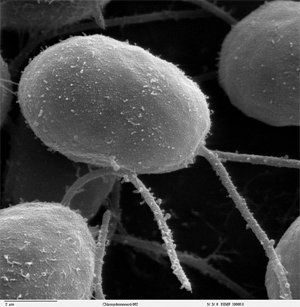Chlamydomonas
 Chlamydomonas is a very large genus of unicellular, motile flagellates occurring in stagnant water and on damp soil, in freshwater, seawater, and even in snow as "snow algae". The cells have a glycoprotein wall (not cellulose despite frequent mention in older text-books) and two equal flagella. The nucleus is enclosed in a cup-shaped chloroplast, which has a single large pyrenoid where starch is formed from photosynthetic products. Two small contractile vacuoles, which have an excretory function, are located near the flagella. There is also a red pigment spot which is light-sensitive, allowing the cell to swim towards light. There is a lot of variation in reproduction in the different species of the genus, and recent studies of its phlogeny suggest that several genera are involved.
Chlamydomonas is a very large genus of unicellular, motile flagellates occurring in stagnant water and on damp soil, in freshwater, seawater, and even in snow as "snow algae". The cells have a glycoprotein wall (not cellulose despite frequent mention in older text-books) and two equal flagella. The nucleus is enclosed in a cup-shaped chloroplast, which has a single large pyrenoid where starch is formed from photosynthetic products. Two small contractile vacuoles, which have an excretory function, are located near the flagella. There is also a red pigment spot which is light-sensitive, allowing the cell to swim towards light. There is a lot of variation in reproduction in the different species of the genus, and recent studies of its phlogeny suggest that several genera are involved.
There are two types of cycle within the life history: an asexual one and a sexual one. Typically, asexual reproduction is by fission (splitting into fragments like nulcear fission), the protoplast dividing to form 4-8 zoospores similar to the parent. In the sexual cycle, nitrogenous compund deprivation induces cells to form isogametes, which fuse in pairs, forming a zygote; the zygote loses its flagella and forms a thick wall which is resistant to adverse conditions; when conditions are again favourable the zygote undergoes meiosis to form 4 haploid zoospores.
The most widely used laboratory species is Chlamydomonas reinhardtii, which can grow on a simple medium of inorganic salts, using light to provide energy. They can also grow in total darkness if an alternative carbon source, such as acetate, is provided. When deprived of nitrogenous compounds, haploid cells of opposite mating types (usually referred to as "plus" and "minus" usually fuse to form a diploid zygospore which forms a hard outer wall that protects it from adverse environmental conditions. When conditions improve (or when the scientist restores nitrogenous compunds to the culture medium and provides light and water), the diploid zygote undergoes meiosis and releases four haploid cells which then resume the vegetative life cycle.
Chlamydomonas is used as a model system for research on many very fundamental questions in cell and molecular biology such as: how do cells move? How do they respond to environmental stimuli such as light? How does photosynthesis work? How do cells recognize one another?
Speices of the genus are widespread in freshwater, although marine species are much less common. Habitats include soil, temporary pools, eutrophic lakes and melting snow (e.g., C. nivalis). Two marine species (C. provasolii and C. hedleyi) are found only in symbiotic association with foraminifera.
*AlgaeBase includes about 250 species of Chlamydomonas. There is a full description of the genus on the site.





